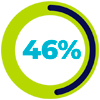Key findings
The NASUWT Wellbeing at Work Survey 2024 ran from mid-September 2023 through to early January 2024.
The survey was notified to NASUWT members via email and 11,754 teachers responded – a similar response rate to the previous survey which took place from December 2021 to January 2022 (hereafter referred to as 2022).
You can further explore data from the 2024 and 2022 surveys via our Explore the Data page.
Warwick-Edinburgh mental wellbeing scale score
As in 2022, we asked teachers to score themselves on the 14-scale Warwick-Edinburgh mental wellbeing scale, an internationally recognised measure of mental health and wellbeing constructed jointly by Warwick and Edinburgh Universities.
The overall score across all teachers was 38.4, a decline of 0.3 points from the 2022 survey.
This score is significantly below the typical mean scores (around 50-52) reported for the general population and highlights a critical issue of low mental wellbeing within the teaching profession.
Personal experience of wellbeing issues
This section focused on teachers’ experiences of wellbeing issues and how their job impacts their mental and physical health.
As with previous iterations of this survey, workload is still the main factor that has been responsible for creating work-related stress for teachers.
-
84% of teachers have experienced more work-related stress in the last 12 months (down 6% from 2022);
-
86% report that their job has adversely impacted their mental health in the last 12 months (down 5% from 2022);

report that their job has adversely impacted their physical health in the last 12 months (up 4% from 2022);

say that workload (up 2% from 2022) has been the main factor for increased work-related stress, followed by pupil behaviour (36%, up from 12%), monitoring and accountability measures (26%), pupil academic performance (19%, down from 3%) and financial worries (19%, up from 8%).
We asked teachers what the impact of stress was on their lives. Key findings include:
-
84% have experienced an increase in anxiousness (down 3% from 2022);

have suffered loss of sleep (up 5% from 2022);

said low energy levels (up 6% from 2022);

have experienced a loss of appetite (up 10% from 2022);
-
10% have had a relationship breakdown;
-
7% stated increased use of prescription drugs (no change since 2022); and
-
3% have self-harmed (up 0.5% from 2022).
School response to wellbeing issues
Teachers were asked about how they felt their school responded to issues around wellbeing and mental health. The results are concerning:

say their school does not provide staff with workspaces that promote wellbeing (down 5% from 2022);
-
64% say that their school does not have measures in place to monitor and manage stress and burnout (down 2% from 2022);
-
63% say that their school/college does not have a school-based counsellor who is accessible to both staff and students/pupils (down 3% from 2022);
-
58% say that their school does not provide flexible working opportunities (up 8% from 2022);
-
54% say that their school does not provide staff with a safe and comfortable space to take time out and debrief outside the classroom environment (down 9% from 2022);

disagree/strongly disagree that their school provides clear policies on their right to switch off and guidelines as to when they should reply to emails at weekends and evenings, with only 12% agreeing/strongly agreeing (new question this year);
-
45% say their school does not have staff wellbeing/mental health training in place (down 3% from 2022);
-
44% disagree/strongly disagree (down 7% from 2022) that their school/college gives the same consideration and support to mental health as physical health, including in the management of staff absence;
-
44% disagree/strongly disagree that their school works with NASUWT and other trade unions to promote staff wellbeing – only 16% agree/strongly agree (down 4% from 2022);
-
35% say their school does not take seriously issues of women’s health and wellbeing (new question this year);
-
only 6% say their school has policies to support women teachers around menstrual health and only 17% of teachers say that their school has policies to support women teachers with issues arising from the menopause (new question this year); and
-
42% say their school has an annual wellbeing survey (up 3% from 2022), with 33% saying their school does not and 25% unsure.
The teaching profession and wellbeing
Teachers are very clear about the national education contexts within which they work and their workplace’s stance on teacher wellbeing issues.
Very few teachers view the national picture surrounding the profession and wellbeing as a positive one, with particular problems being the impact of government inspectorate regimes and a lack of support from government policies:
-
70% (down 1% from 2022) disagree/strongly disagree that government policies support schools to respond to mental health and wellbeing issues that affect teachers, with only 3% agreeing/strongly agreeing;

(up 4% from 2022) strongly disagree with the statement ‘My country’s inspectorate regime takes teacher mental health and wellbeing into account when assessing schools’, with a further 28% disagreeing and only 3% agreeing/strongly agreeing;

agree/strongly agree that the way their country’s inspectorate regime carries out its work has a negative impact on teacher mental health and wellbeing, with only 6% disagreeing/strongly disagreeing (new question this year); and
-
53% disagree/strongly disagree that government policies are focused on tackling the stigma around mental health, with only 12% agreeing/strongly agreeing.
Demographic summary
-
The survey was completed by 11,754 members of the NASUWT.
-
80% of respondents were from England, 3% from Scotland, 7% from Northern Ireland, 9% from Wales and 1% from Crown Dependencies.
-
33% were primary phase teachers, 57% were secondary phase teachers, 6% were from special education and 2% were sixth-form college/further education teachers.
-
77% of respondents were women.
-
92% identified as White, 2% as Asian/Asian British, 1% as Black and 2% as Mixed Ethnic Group.
Conclusion
The NASUWT wellbeing at work survey 2024 highlights persistent and concerning issues in the teaching profession regarding mental and physical health.
Despite some improvements since the 2022 survey, such as slight reductions in work-related stress and adverse mental health impacts, the overall picture remains troubling.
The data reveals that workload continues to be the primary source of stress for teachers, compounded by increasing issues related to pupil behaviour and financial worries.
The impact of stress on teachers’ lives is profound, with significant percentages reporting anxiety, sleep loss, low energy and even self-harm. These findings point to a critical need for more effective support systems within schools.
The response from schools to these wellbeing issues appears inadequate.
A majority of teachers report a lack of supportive workspaces, stress management measures, accessible counsellors and flexible working opportunities. Additionally, policies on communication during off-hours and support for women’s health issues are notably lacking.

